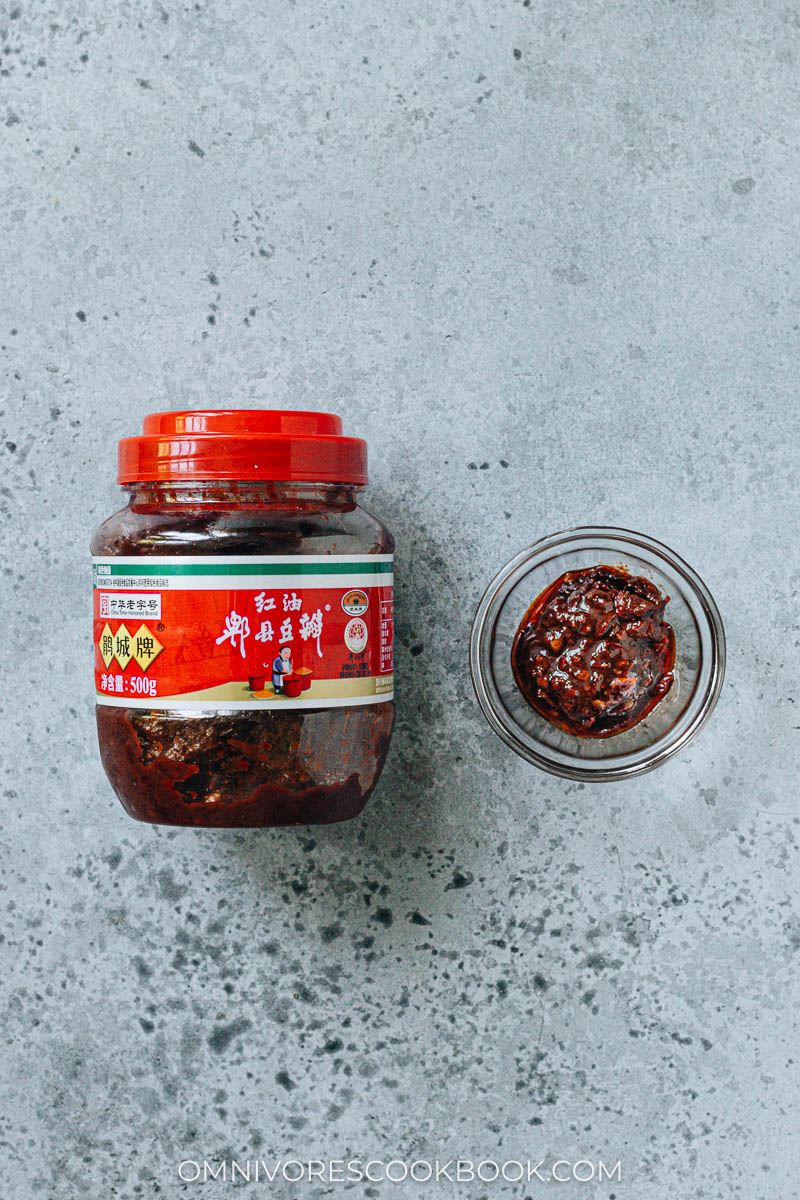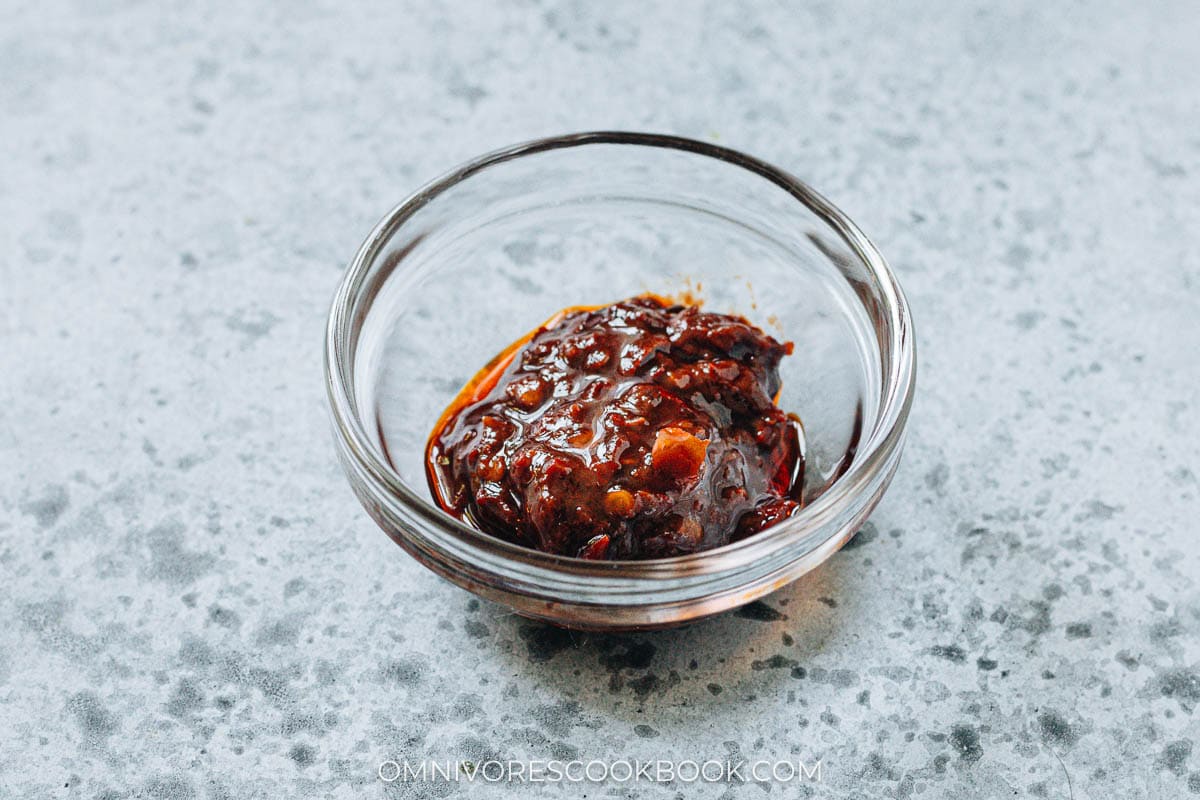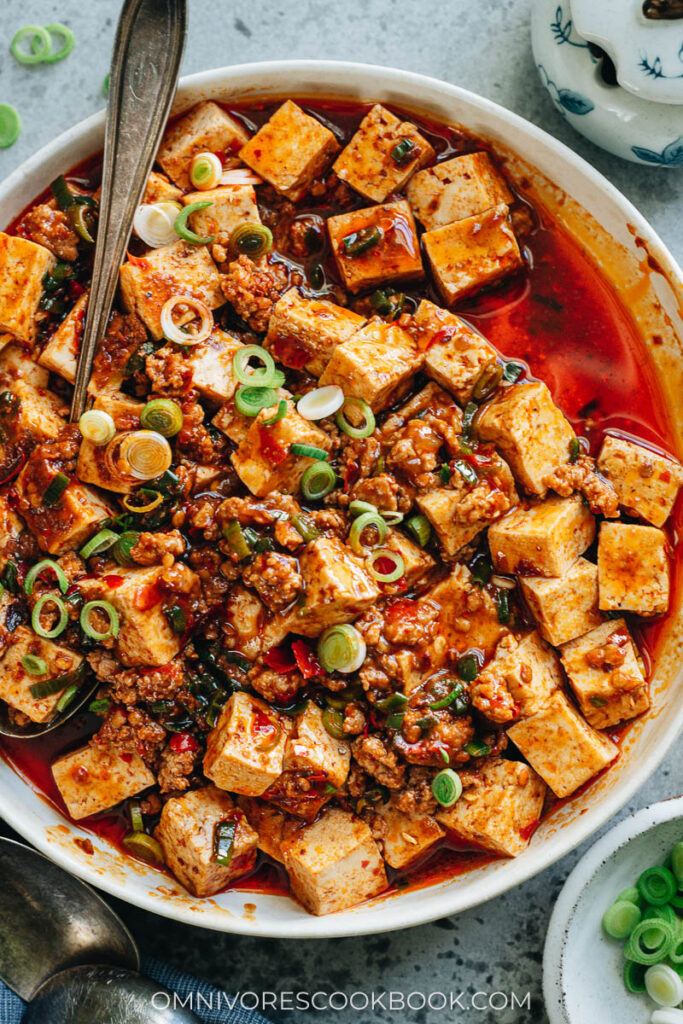
What is Doubanjiang?
Doubanjiang is a fermented mixture of fava beans (aka broad beans), Sichuan chili peppers, salt, wheat flour, and often oil and various spices. It forms a thick, reddish-brown paste with pieces of bean and chili peppers and seeds. Doubanjiang has a complex and potent fragrance that is funky and fruity.
It is one of the most well-known and widely used Sichuan (aka Szechuan) ingredients and it plays a special role in creating the signature Sichuan flavor.
How is Doubanjiang Made?
The process for making Doubanjiang dates back hundreds of years, though it has evolved over time. But here is the gist of it:
- Fava beans are steamed until tender, then allowed to cool until still warm.
- They are mixed with wheat flour and inoculated with a yeast starter to begin the fermentation process. After some initial fermentation the beans are allowed to dry in the sun and then rinsed.
- Separately, fresh chili peppers are salted, crushed, and allowed to ferment.
- The beans may be allowed to ferment further with the addition of alcohol, before being mashed and mixed with the fermented chili peppers.
- Spices and salt are added to the mixture before it goes into a clay urn, where it is aged in direct sunlight for a few months up to several years.
A particular type of chili pepper from Sichuan, called erjingtiao, is used in doubanjiang. Erjingtiao chilis have a medium heat level and a fruity aroma, both of which are important parts of doubanjiang’s flavor.
What Does Doubanjiang Taste Like?
Doubanjiang has a concentrated salty umami with moderate chili pepper heat and complex, funky fermented notes that range from fruity to earthy. By itself, doubanjiang is much too intense to eat, but diluted and combined with other ingredients it creates an unforgettable spicy-savory aroma and flavor base.
If you’ve enjoyed Sichuan hot pot or mapo tofu, you’re already familiar with the beauty of doubanjiang.

How to Use Doubanjiang
Doubanjiang can be used with a few different cooking methods to lend its spicy, earthy goodness to Sichuan and other Chinese dishes. It is most often used with ginger, garlic, chili pepper, and Sichuan peppercorn for the iconic Sichuan flavor profile.
When using doubanjiang in any dish, be sure to stir well to combine it with the other ingredients. The paste is quite thick and you’ll want to disperse its concentrated flavor evenly.
Here are the most common ways to use doubanjiang:
- Stir Fry Sauce – both Sichuan Beef and Home Style Tofu use douban in a stir fry
- Braising Broth – Pork and Vegetable Stew shows the beauty of doubanjiang with slow-cooked meat and it’s the key ingredient in Mapo Tofu
- Hot Pot Broth – Classic Sichuan Hot Pot and Sichuan Fish with Pickled Greens are both bursting with umami and spice aided by doubanjiang


How to Shop
You can easily find doubanjiang at your local Chinese market or online. My go-to shop is the Mala Market, which imports the highest quality ingredients directly from Sichuan.
For doubanjiang brands and types, you can’t go wrong with any variety of Pixian Doubanjiang. Pixian is a region rather than a brand, but it is a good indicator of quality. The company behind Juancheng Pixian Doubanjiang has been producing the ingredient in Sichuan since 1688. It is fermented for one year and is the most common and the best for everyday cooking.
For a special upgrade, the same company makes a premium 3-year fermented doubanjiang that is made with traditional methods and no preservatives or pesticides. It is both more mellow and more complex than the 1-year, and I love the huge, rounded flavor it gives my dishes.
There may be other types of doubanjiang, some of which may not be good for Sichuan cooking. If you see the words Pixian (郫县) or Sichuan (四川) you should have the right product. Also, chili pepper should be the first ingredient on the label.
I advise you to AVOID these types of doubanjiang:
- Youki brand – just tastes salty and has no fermented complexity
- Lee Kum Kee brand (“Toban Djan”) – not close to authentic Sichuan flavor
How to Store
Once opened, store doubanjiang in the fridge in the jar it came in, or in an airtight container. Since it is fermented and heavily salted it should be good for a year from opening. Be sure to use a clean, dry spoon to scoop it out.
Unopened, it should last a couple of years in a cool, dark cupboard.
Substitutions
To be blunt, there is no proper substitute for doubanjiang.
Korean doenjang has some of the same earthy umami as doubanjiang, though none of the chili pepper spice or aroma. Combine doenjang with some Chinese chili flakes or chili oil and you could have an OK imitation.
I do NOT recommend Korean gochujang because it is much too sweet and lacks umami.
I do NOT recommend Korean ssamjang because it contains gochujang, which is too sweet.
Also, I avoid using Japanese miso because it has quite a different character and isn’t intended to be used in the same way as doubanjiang.
FAQ
It is neither of these. See the section above on How to Buy.
You can, but in small amounts, so that you don’t overpower the dish. For example, it can give American-style chili a nice umami boost and blend in with the other spices. And it can help give braised pork and beef some depth of flavor and a bit of spice.
By itself, doubanjiang is much too thick and salty to be practical. It is not really used in dipping sauces in Chinese cooking. Chili oil and soy sauce make much better spicy and umami ingredients for dipping sauce.
Dishes that Feature Doubanjiang
Here are some of my favorite dishes that show what doubanjiang is capable of:
